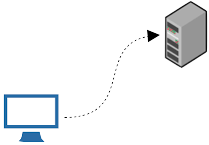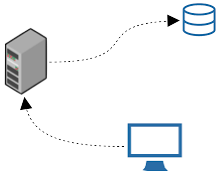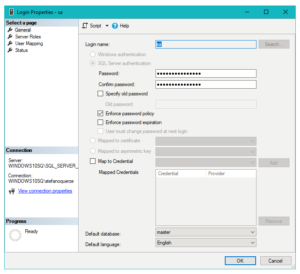 In a classic client-server program, the client has direct access to the database, and this causes relevant inconveniences:
In a classic client-server program, the client has direct access to the database, and this causes relevant inconveniences:
- Reduction of data security
- Slow reading of many records, especially in wireless connections
- Increase of network traffic
 In the X-Cross three tier data server all these inconveniences are eliminated, with a faster and more secure data structure.
In the X-Cross three tier data server all these inconveniences are eliminated, with a faster and more secure data structure.
Furthermore, this data structure can offer an improved connection stability with respect to the client-server model.
Data security
 If the client has direct access to the database, its access credentials can be used by a skilled user in every type of connection, and from any program that can read a database.
If the client has direct access to the database, its access credentials can be used by a skilled user in every type of connection, and from any program that can read a database.
In the X-Cross three tier data model, instead, the user does not have a direct access to the database, but only to the Cloud server, from which the calls are redirected to the database, that can be accessed only by the Cloud server.
The user, therefore, can perform only the functions that are granted by his access proficle, and cannot do anything except what is included in these grants.
Speed of reading
 In the classic client-server mode, the readings are performed table by table (or view by view), and the records are fetched one by one.
In the classic client-server mode, the readings are performed table by table (or view by view), and the records are fetched one by one.
Consequantly, the reading that involve a large number of tables (e.g. an invoice with all the connected tables) is read one table at a time, and the records of every table are fetched one by one.
If we read only one table or view with many records, the reading is only one, but the records are fetched one by one.
In very fast LANs, the difference is negligible, but in wireles LANS, that are much slower, the X-Cross database server is siggnificantly faster that the classic client server model.
Furthermore the speed, even in fast LANs, is negatively affected by the network traffic, that can be drastically reduced by the X-Cross database server.
Reduced network traffic
 The X-Cross three tier data model, with respect to the classic client server, can offer a reduction of the network traffic by 60-70%, while at the same time improving the speed of data readings, giving an additional contribution to improve the performance of the whole system.
The X-Cross three tier data model, with respect to the classic client server, can offer a reduction of the network traffic by 60-70%, while at the same time improving the speed of data readings, giving an additional contribution to improve the performance of the whole system.
Improved stability of the connection
 The client-server database connection requires a constant bidirectional connection between client and server. If something, even minimal, goes wrong, the connection is lost and the client needs to reconnect.
The client-server database connection requires a constant bidirectional connection between client and server. If something, even minimal, goes wrong, the connection is lost and the client needs to reconnect.
This can happen in “heavy duty” environments, for example for electric and magnetic fields, but also for other reasongs, and sometmes for no apparent reason.
The X-Cross three tier model, instead, used an asynchronous connection, the does not need to be continuous.
For example, the user can disconnect the laptop from the office network, go to another location and connect to his network ot with a mobile hotspot, and continue the work from the previous point, as if the connection ws never interrupted.
In this way, the connection is always much more stable, and we have expericnced it directly in previously problematic environments, that worked uninterruptly with this type of technology.